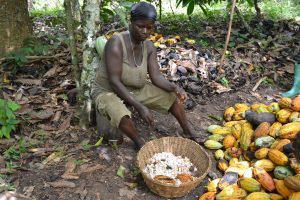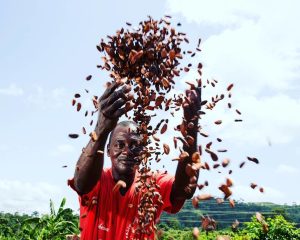A country known for its historical richness and cultural diversity, Ghana also holds a significant position in the global cocoa industry.Ghana stands as the second-largest cocoa producer in the world, playing a crucial role in the global cocoa market. The cocoa sector has been deeply embedded in Ghana’s history, shaping not only its economy but also influencing its culture and social fabric. This article aims to provide a comprehensive overview of the cocoa world in Ghana, discussing the various challenges faced by cocoa farmers, the impact of the chocolate industry on the country, and the potential solutions to these challenges.
The cocoa industry is essentially the backbone of Ghana’s economy, contributing significantly to its GDP and providing livelihoods to millions of Ghanaians. Ghana’s fertile soil and favorable climate make it an ideal location for cocoa cultivation, producing beans known for their unique flavor and quality. However, the industry is currently facing multiple challenges, including falling incomes for farmers, deforestation, and an imbalanced supply chain. These issues pose a significant threat to the sustainability of the cocoa industry and the livelihoods of those dependent on it.
The Plight of Ghana’s Cocoa Farmers



The plight of Ghanaian cocoa farmers is a pressing issue that demands urgent attention. These farmers have been experiencing falling incomes, with a significant average decrease of 16% since 2020. A range of factors contribute to this decline, including the impact of the COVID-19 pandemic, the ongoing war in Ukraine, climate change, and the challenges posed by aging farms. These external factors have resulted in an increasingly difficult environment for farmers to earn a living income, leading to dire consequences such as the use of child labor and deforestation as they struggle to make ends meet.
To illustrate the severity of the situation, we can look at the impact of the COVID-19 pandemic. The global health crisis has drastically disrupted supply chains and shrunk demand for cocoa, resulting in a steep fall in prices for farmers. Additionally, the war in Ukraine has led to a significant rise in the cost of fertilizers, making it more costly for farmers to maintain their cocoa farms. Climate change has also played a part, introducing erratic weather patterns that affect crop yields, making it harder for farmers to effectively manage their farms. Lastly, many cocoa farms in Ghana are aging, resulting in lower productivity and making it increasingly difficult for farmers to maintain their incomes.
The situation is further exacerbated by the obstacles farmers face in accessing financial services and agricultural training. Lack of access to credit makes it difficult for farmers to invest in inputs like fertilizers and improved seedlings, which are crucial for maintaining productivity. Similarly, a lack of training and knowledge on best agricultural practices hinders farmers’ ability to improve their yields and incomes.
The Profitability of the Chocolate Industry
In stark contrast to the struggles faced by Ghana’s cocoa farmers, the world’s biggest chocolate firms are enjoying substantial profits. Companies like Hershey, Lindt & Sprüngli, Mondelēz, Nestlé, Mars, and Ferrero have made nearly $15 billion in profits since the pandemic began. Private chocolate corporations Mars and Ferrero have seen their wealth rise by an extraordinary $39 billion since 2020. This disparity in financial success is striking, especially as these profits have not translated into meaningful increases in payments to the cocoa farmers who form the backbone of the industry.
The chocolate industry’s profitability is a testament to the global demand for this beloved treat. The global chocolate sales surpassing $100 billion annually, with the majority of the profits concentrated in the hands of chocolate manufacturers and retailers, rather than the farmers who produce the cocoa. This inequitable distribution of profits raises serious concerns about the fairness and sustainability of the cocoa industry.
Adding to the imbalance is the fact that cocoa farmers often lack bargaining power and have limited ability to negotiate higher prices for their beans. This is largely due to the fragmented nature of the cocoa farming sector in Ghana, which consists mainly of smallholder farmers who individually have little influence over market prices. Furthermore, the vast distance between cocoa farmers in Africa and chocolate consumers in the developed world creates a disconnect, making it difficult for consumers to understand the plight of farmers and demand fairer practices.
The Imbalance in the Cocoa Supply Chain
- The cocoa supply chain exemplifies inequality between chocolate companies and cocoa farmers in Ghana.
- Farmers receive meager incomes that often don’t meet basic needs.
- Despite chocolate manufacturers’ profits, farmer incomes remain low.
- This perpetuates poverty and undermines industry sustainability and fairness.
- The supply chain is complex, with farmers getting a small fraction of the chocolate’s retail price.
- Most profits are captured by intermediaries, processors, and manufacturers.
- The economic injustice has social and environmental consequences.
- Low incomes lead farmers to unsustainable practices, threatening the environment.
- There are calls for transparency and traceability in the cocoa supply chain.
- Systems for fair prices and origin tracing of cocoa beans are advocated.
The Role of Sustainability Programs in Cocoa Production
Sustainability programs have been introduced by several top chocolate manufacturers and traders operating in Ghana. However, these programs have not effectively increased cocoa production or farmer income. In fact, crop yields of farmers within these corporations’ supply chains have declined by 25% between 2020 and 2022. While some companies, such as Lindt & Sprüngli, have made efforts by paying Ghanaian farmers a premium and investing over $20 million in cocoa sustainability programs, the overall impact on farmer income and cocoa production remains limited.
One example of a sustainability program is the certification system, which aims to promote environmentally and socially responsible cocoa production. However, these certification programs have faced criticism for their efficacy. The high costs associated with gaining and maintaining certification, coupled with the lack of consistent price premiums for certified cocoa, have made it difficult for many farmers to benefit from these programs. At the same time, the focus on certification has often overshadowed other crucial aspects of sustainability, such as improving farm productivity, enhancing farmer livelihoods, and promoting biodiversity.
Another widely implemented sustainability program is the Fairtrade system. This model guarantees a minimum price for cocoa beans and provides additional premiums that can be invested in community development projects. However, the reach of the Fairtrade system in the cocoa sector is limited, with only a small percentage of the world’s cocoa farmers benefitting from Fairtrade certification.
While sustainability programs can play a crucial role in promoting better practices in the cocoa sector, there is a need for a more holistic approach. Improving farmers’ access to education and training, providing better access to finance, promoting diversification into other crops, and investing in local infrastructure are all vital aspects of creating a truly sustainable cocoa industry.

